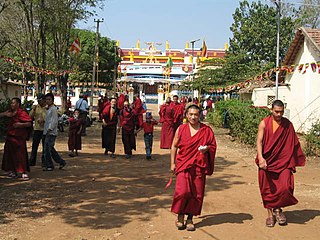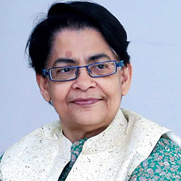
Positron emission tomography (PET) is a functional imaging technique that uses radioactive substances known as radiotracers to visualize and measure changes in metabolic processes, and in other physiological activities including blood flow, regional chemical composition, and absorption. Different tracers are used for various imaging purposes, depending on the target process within the body.
The Jawaharlal Nehru Centre for Advanced Scientific Research (JNCASR) is a multidisciplinary research institute located at Jakkur, Bangalore, India. JNCASR was established by the Department of Science and Technology of the Government of India as a centre for advanced scientific research in India, to mark the birth centenary of Pandit Jawaharlal Nehru, the first prime minister of independent India. In 2019, JNCASR was ranked #7 among the world's top ten research institutes and universities by Nature journal in a normalised ranking of research institutes and universities with high quality output.

[18F]Fluorodeoxyglucose (INN), or fluorodeoxyglucose F 18, also commonly called fluorodeoxyglucose and abbreviated [18F]FDG, 2-[18F]FDG or FDG, is a radiopharmaceutical, specifically a radiotracer, used in the medical imaging modality positron emission tomography (PET). Chemically, it is 2-deoxy-2-[18F]fluoro-D-glucose, a glucose analog, with the positron-emitting radionuclide fluorine-18 substituted for the normal hydroxyl group at the C-2 position in the glucose molecule.

The National Institute of Mental Health and Neuro-Sciences is a medical institution in Bengaluru, India. NIMHANS is the apex centre for mental health and neuroscience education in the country. It is an Institute of National Importance operating autonomously under the Ministry of Health and Family Welfare. NIMHANS is ranked 4th best medical institute in India, in the current National Institutional Ranking Framework.

2-Deoxy-d-glucose is a glucose molecule which has the 2-hydroxyl group replaced by hydrogen, so that it cannot undergo further glycolysis. As such; it acts to competitively inhibit the production of glucose-6-phosphate from glucose at the phosphoglucoisomerase level. 2-Deoxyglucose labeled with tritium or carbon-14 has been a popular ligand for laboratory research in animal models, where distribution is assessed by tissue-slicing followed by autoradiography, sometimes in tandem with either conventional or electron microscopy.

Manchanahalli Rangaswamy Satyanarayana Rao was an Indian scientist. He was awarded the fourth-highest civilian award, the Padma Shri, for Science and Engineering in 2010. From 2003 to 2013 he was president of Jawaharlal Nehru Centre for Advanced Scientific Research (JNCASR) in Bangalore, India.
Simon N. Powell is a British cancer researcher and radiation oncologist residing in New York City.

Dinakar Masanu Salunke is an immunologist and structural biologist Presently, he is the Director of International Centre for Genetic Engineering and Biotechnology (ICGEB) New Delhi. Earlier he was the Executive Director of newly established Regional Centre for Biotechnology (RCB), an institution jointly set up by Department of Biotechnology (India) and UNESCO at Faridabad. He is the recipient of Shanti Swarup Bhatnagar Prize for Science and Technology in the category of biological sciences and Fellow of all major science academies in India.
Hubert Rodney Withers was an Australian radiation biologist and physician. He made many contributions to the fields of radiobiology and clinical radiation therapy, but he is best known for his work on post-radiation tissue repair and the effects of ionizing radiation on normal tissues.
Vallampadugai Srinivasa Raghavan Arunachalam was an Indian scientist and former head of Defence Research & Development Organization (DRDO). He was the founder and chairman of CSTEP, a science and technology think tank.

Henry Harrington Janeway was an American physician and pioneer of radiation therapy.
Dr. Kodaganur S. Gopinath, MS, FAMS, FRCS (Edin) is an Indian surgical oncologist, known for his pioneering work on oncological research. He is a recipient of many awards including Dr. B. C. Roy Award, considered to be the premier medical honour in the country. The President of India recognised his services to the field of oncology, by awarding him the fourth highest civilian award, Padma Shri, in 2010.
Metabolic trapping refers to a localization mechanism of synthesized radiocompounds in the human body. It can be defined as the intracellular accumulation of a radioactive tracer based on the relative metabolic activity of the body's tissues. It is a basic principle of the design of radiopharmaceuticals as metabolic probes for functional studies or tumor location.
Vakkaleri Narayana Rao was an Indian defence scientist and one of the pioneers of Electronic Warfare in India. He was a former director of the Defence Electronics Research Laboratory, Hyderabad. The Government of India awarded him the fourth highest Indian civilian honour of Padma Shri in 1982.

Bilikere is a small town in Hunsur taluk of Mysore district in the Indian state of Karnataka.
Sandip Basu is an Indian physician of Nuclear Medicine and the Head, Nuclear Medicine Academic Program at the Radiation Medicine Centre. He is also the Dean-Academic (Health-Sciences), BARC at Homi Bhabha National Institute and is known for his services and research in Nuclear Medicine, particularly on Positron emission tomography diagnostics and Targeted Radionuclide Therapy in Cancer. The Council of Scientific and Industrial Research, the apex agency of the Government of India for scientific research, awarded him the Shanti Swarup Bhatnagar Prize for Science and Technology, one of the highest Indian science awards for his contributions to Nuclear Medicine in 2012.
Lorenzo Galluzzi is an Italian and French cell biologist best known for his experimental and conceptual contributions to the fields of cell death, autophagy, tumor metabolism and tumor immunology.

Sanjeev Das is an Indian cancer biologist and a scientist at National Institute of Immunology, New Delhi, India. He is well regarded for his studies on tumor suppressor proteins. He is a recipient of the National Bioscience Award for Career Development of the Department of Biotechnology. The Council of Scientific and Industrial Research, the apex agency of the Government of India for scientific research, awarded him the Shanti Swarup Bhatnagar Prize for Science and Technology, one of the highest Indian science awards, for his contributions to biological sciences in 2017.

Chandrima Shaha is an Indian biologist. As of September 2021, she is the J. C. Bose Chair Distinguished Professor at the Indian Institute of Chemical Biology, Kolkata. She is the former Director and former Professor of Eminence at the National Institute of Immunology. She was the President of Indian National Science Academy (2020–22) and the Vice President of the same academy (2016–2018). She is an elected fellow of the World Academy of Sciences, Indian National Science Academy, Indian Academy of Sciences, National Academy of Sciences and the West Bengal Academy of Science and Technology.
Kristy Brock is a professor in the Department of Imaging Physics, Division of Diagnostic Imaging and is an adjunct professor in the Department of Radiation Physics, Division of Radiation Oncology at the University of Texas MD Anderson Cancer Center, Houston.









